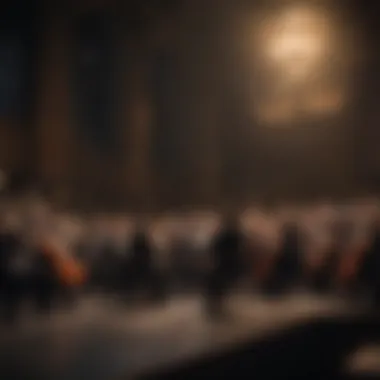Exploring the Best Intro Songs: A Musical Journey


Intro
Intro songs have a unique power in music; they can captivate listeners and set the tone for what follows. The right intro can provoke strong emotions, create anticipation, or even tell a story before the main content of a track begins. This article explores the significance of intro songs by assessing their characteristics and impact across various genres. By delving into the elements that make these moments remarkable, we celebrate the art of songcraft and its ability to enhance the listener's experience.
Artist Profile
Biography and Background
Many artists leverage their intro songs to establish their identity or musical themes effectively. Understanding an artist's background can provide context for their creative choices. Take Pink Floyd, for instance, known for their atmospheric and immersive soundscapes. Their intros often utilize haunting sounds or soft melodies, inviting listeners into a journey before the main themes emerge. Each artist's biography adds layers to their work, influencing how their intros resonate with audiences.
Major Influences and Inspirations
An artist’s influences shape their sound, including their intro tracks. For example, Led Zeppelin drew from blues and folk music, which is evident in their iconic intro of "Stairway to Heaven". The interweaving of genres informs the artistic direction and showcases a blend that intrigues listeners. Often, artists will cite inspirations ranging from literary works to visual arts, contributing to the complexity of their musical intros.
Song Analysis
Theme and Lyrics Breakdown
Themes in intro songs serve as a foundation for the narratives that follow. In The Beatles’ "A Day in the Life", the intro creates a sense of infinite possibility and introspection, hinting at a larger story within the lyrics. This thematic setup compels listeners to engage with the unfolding song. Analyzing the lyrics in tandem with the introductory elements reveals a deeper understanding of the intended message.
Instrumentation and Composition
Instrumentation plays a pivotal role in how an intro sets the stage for a track. For example, the opening of Queen's "Bohemian Rhapsody" features piano chords that create an emotional weight. The composition choices, including tempo, key, and dynamics, enhance the intro’s impact. Many successful intros utilize a gradual build-up, allowing listeners to absorb the layers before the main melody begins.
"The intro is not merely an opening; it's a prelude that elevates the art of storytelling through music."
Closure
Exploring intro songs reveals not only their artistic merit but also their function in shaping a listener's experience. By examining an artist’s background, influences, themes, and instrumentation, one gains insight into the complexity of these musical elements. This understanding deepens the appreciation for the works of artists and enhances our overall engagement with music.
The Significance of Intro Songs
Intro songs serve as the gateway to musical compositions, establishing the mood and context for what is to follow. Their significance cannot be understated, as they set up a listener’s expectations and emotional engagement. To understand the impact these introductions have, one must consider their definition, historical context, and the audience's response.
Definition and Purpose
An intro song is typically defined as the opening track for an album or the first section of a song. Its primary purpose is to establish a sense of theme, atmosphere, or narrative. Many songs utilize intros to create a hook, grabbing the listener's attention from the start. Artists often invest considerable effort into crafting these openings, knowing they can profoundly influence the listener's perception of the entire work. Effective intros can either compel the audience to stay engaged or cause them to skip ahead.
Historical Context
Historically, intro songs have played pivotal roles across various music genres. From operatic compositions to rock anthems, the artistic use of introduction pieces can be traced back centuries. In classical music, many composers, such as Johann Sebastian Bach and Ludwig van Beethoven, used orchestral introductions to establish thematic elements long before lyrics entered the composition. In modern music, the significance has evolved, but the intention remains: to create a connection with the audience. Shortly after the advent of recording technology, radio and television further popularized intro segments, making them more accessible and essential for audience engagement.
Influence on Audience Reception
The way an audience receives music is often heavily predicated on the intro. A compelling introduction can elevate the overall experience, making listeners more invested in the track. Conversely, a weak or uninspired intro could lead to disengagement.
According to studies on musical psychology, the initial moments of a song can evoke emotions that shape the listener's perception throughout. A memorable intro not only resonates with listeners but can also become an integral part of cultural identity. For instance, the iconic opening riff of "Smoke on the Water" by Deep Purple is instantly recognizable, often serving as a benchmark for many aspiring musicians.


"An intro sets the stage for what is to come. Its influence extends beyond mere sound. It is about creating an experience."
Criteria for Iconic Intro Songs
Intro songs wield significant power in shaping a listener's first impression of a musical piece. They are designed to draw attention and establish the mood even before the main body of the song unfolds. An intro can make or break the listener's interest, setting the tone for what follows. This section explores the key criteria that contribute to the making of iconic intro songs, analyzing elements that elevate them and their role in enriching the overall musical experience.
Memorable Melodies
A catchy melody is essential for any intro song. It serves as a hook that lures listeners into the experience. When a melody is memorable, it sticks in the mind, making listeners eager for more. Intro songs that stand out often have a distinctive melodic phrase that listeners can easily recall. Think about the opening notes of Queen’s "We Will Rock You" or the iconic guitar riff of Led Zeppelin’s "Good Times Bad Times." These melodies not only complement the song's theme but also resonate deeply with the audience, prompting an immediate emotional response. The challenge lies in crafting a melody so infectious that it transcends the song itself, becoming a cultural touchstone over time.
Lyrical Impact
Lyrics play a crucial role, especially when they set the stage for the song's narrative. An intro that delivers striking lines can captivate an audience instantly. In a lyrical intro, every word must count, sparking intrigue and curiosity. For example, the opening of Bob Dylan's "Like a Rolling Stone" lays a foundation for the entire piece, prompting listeners to ponder the story about to unfold. Effective lyrics, through their simplicity or depth, can create an immediate connection, drawing listeners into the world of the song long before the chorus arrives. The lyrical impact is particularly notable in genres like folk and hip-hop, where storytelling is paramount.
Production Quality
The relevance of production quality cannot be understated. The introduction of advanced production techniques has transformed how artists create their sound. A well-produced intro can instantly elevate the listening experience. Clear instrumentation, balanced mixes, and immersive soundscapes contribute significantly to how professional a track feels. Take Daft Punk's work in "Around the World"; the quality of sound and effects immediately captures attention. Such production often incorporates elements that highlight the artist's intention and artistic vision, further enriching the listener's experience. The attention to detail in production reflects the artist's commitment to their craft, and that commitment resonates with audiences.
Cultural Relevance
Cultural relevance adds another layer to the significance of intro songs. An intro that connects with the zeitgeist or holds socio-political significance can resonate deeply with audiences. For instance, public enemy's "Fight the Power" starts with powerful lyrics that challenge authority, setting a tone that reflects the struggles of a generation. When intros echo societal themes, they foster a sense of belonging and collective memory among listeners. Furthermore, intro songs that reference or evoke past musical movements often create a bridge between generations, nurturing a shared musical landscape. In the context of a rapidly changing world, the cultural nuances echoed in intro songs become even more important, signaling shifts and movements.
"Intro songs are not merely a prelude; they are an invitation into a world crafted with intetion and artistry."
In summary, the combination of memorable melodies, impactful lyrics, exceptional production quality, and cultural relevance encapsulate the essence of iconic intro songs. By understanding these criteria, music enthusiasts and creators alike can appreciate the intricacies that define these musical pieces.
Analysis of Genre-Specific Intro Songs
The exploration of genre-specific intro songs is crucial in understanding how these musical pieces lay the groundwork for a song's narrative and emotional tone. Each genre employs unique stylistic elements that help in crafting intros, delivering distinct experiences for listeners. By breaking down these elements, one can appreciate how intonation, rhythm, and instrumentation contribute to the overall impact of the song. The allure of a powerful intro often sets expectations for what follows, thus enhancing the listener's engagement.
Rock: The Anthemic Openers
Rock music is known for its energetic and powerful sound, and the intro songs often encapsulate this essence. Anthems in rock serve not only as a prelude but as a rallying cry for listeners. Key guitar riffs and strong drum beats are standard elements here. For example, the opening guitar riff from "Smoke on the Water" by Deep Purple creates an immediate recognition and sense of excitement. The energy delivered in these first few seconds is meant to captivate.
The memorable nature of rock intros encourages sing-alongs and sets a lively atmosphere at concerts. This genre heavily relies on the emotional weight that the intro carries, often reflecting the themes explored in the subsequent lyrics.
Pop: Crafting an Instant Connection
Pop music excels in crafting connections, and the role of intro songs is foundational in achieving this goal. A catchy melody or a striking hook can pull listeners immediately into the experience. Tracks like "Uptown Funk" by Mark Ronson demonstrate how a short yet infectious intro can lead to widespread enjoyment.
The lyrics often address relatable themes, which, when combined with an engaging intro, establish an instant bond with the audience. This connection not only garners attention but also encourages repeated listens and sharing, making the track resonate across different demographics.
Hip-Hop: Establishing an Identity
In Hip-Hop, intros significantly contribute to establishing the artist's identity right from the start. A powerful intro sets the tone for the lyrical prowess that will follow. For instance, in tracks like "Juicy" by The Notorious B.I.G., the intro creates a sense of anticipation and context for the artist's narrative.
Rhythmic beats and unique sampling methods often characterize these openings, aligning with the cultural roots of the genre. Moreover, distinctive intros can serve as statements of intent, showcasing the artist's style and perspective while immediately connecting with the listener.


Electronic: Setting the Mood
Electronic music relies heavily on atmosphere, and intros play a critical role in mood setting. Lengthy, evolving intros can prepare listeners for the journey a track will take them on. Tracks like "Strobe" by Deadmau5 exemplify how electronic intros use ambient sounds to build tension before dropping into the main body of the song.
The incorporation of layers, textures, and minimalistic pieces can create an immersive experience that captivates the audience. This genre's intros tend to favor subtlety and progression, inviting exploration and deep listening.
In summary, excellent intro songs in each genre not only reveal their unique attributes but also create a platform for artists to communicate their message effectively.
Top Ten Most Impactful Intro Songs
The top ten most impactful intro songs play a crucial role in this exploration of musical brilliance. These tracks not only kick off albums but also create an enduring impression on listeners. Understanding the specific elements that make these intros effective offers insights into their broader relevance in music. This section presents an opportunity to examine how various components, including melody, structure, and emotional engagement, come together to enhance a song's impact.
Analysis of Each Song
Each of these ten intro songs has a unique story. The analysis focuses on their distinctive characteristics:
- "Smells Like Teen Spirit" by Nirvana: This track's raw energy and catchy riff set a rebellious tone for the grunge movement. Its layered guitar sounds combined with Kurt Cobain's vocal intensity create an immediate connection.
- "Thriller" by Michael Jackson: The haunting opening of this track lures listeners into a world of suspense. It incorporates sound effects that enhance the narrative, engaging the audience right from the start.
- "Baba O'Riley" by The Who: The synthesizer introduction is instantly recognizable. It builds into a powerful anthem that reflects themes of youth and freedom.
- "Crazy in Love" by Beyoncé: Featuring a brassy horn section, this intro creates a confident atmosphere that sets the stage for the song's themes of passion and desire.
These intros utilize various musical techniques, like hooks, rhythms, and instrumentation, to captivate listeners even before the lyrics are delivered.
Artist Contributions
The artists behind these iconic intros significantly shape their sound and significance. For example:
- Kurt Cobain's raw vocals and songwriting give Nirvana a distinctive edge and resonate with a disenchanted youth.
- Michael Jackson blends theatricality and musical innovation, which transcends genres and allows his work to resonate with diverse audiences.
- Beyoncé's ability to fuse R&B with contemporary elements demonstrates her versatility and sets a new standard in pop music.
Their contributions are not just musical; they challenge and inspire others within their genres and beyond.
Cultural Significance
These intro songs hold cultural importance as they go beyond mere entertainment. They often represent social movements, emotional experiences, or shifts in musical landscapes. For example:
- "Smells Like Teen Spirit" became an anthem for disaffected youth, symbolizing a generation's frustrations and desires.
- "Thriller" revolutionized music videos, blending visual storytelling with music and establishing a new cultural phenomenon.
This cultural context provides deeper understanding of the impact of these songs. The lasting echoes of their intros and the emotions they convey speak volumes about the artists' intentions and the era they represent.
The Role of Technology in Intro Songs
The integration of technology in music has fundamentally transformed the landscape of intro songs. With advances in sound production, musicians now have a wider array of tools and platforms to create and manipulate sounds. This evolution has not only influenced the quality of the intro tracks but also shaped the listener's experience and interaction with music.
Evolution of Sound Production
From the onset of recorded music, the evolution of sound production has been rapid and profound. Early recording techniques were rudimentary and limited, often leading to high levels of distortion and a lack of clarity. However, as technology progressed, producers gained access to more sophisticated tools.
Today, Digital Audio Workstations (DAWs) like Ableton Live and Pro Tools enable meticulous control over sound. Artists can layer various sounds, manipulate audio tracks, and incorporate sound effects seamlessly. This capability allows for the creation of compelling intros that capture attention and set the mood for the entire song.
Furthermore, innovations such as MIDI technology allow for greater experimentation with synths and samples, leading to unique and memorable intros that resonate with listeners.


Digital vs. Analog
The debate between digital and analog production methods continues within the music community. Both mediums have distinct characteristics that can influence how an intro song is crafted.
- Analog: Often revered for its warmth and organic quality, analog equipment can produce a rich sound. Artists using analog gear might achieve a nostalgic tone that digital formats can sometimes emulate but rarely replicate.
- Digital: Conversely, digital production offers precision and versatility. It allows for easy manipulation of sounds, making it possible to experiment with various effects and alterations. With digital platforms, musicians can produce intricate pieces without the constraints of physical equipment.
Ultimately, the choice between analog and digital can shape the sound and impact of intro songs. Artists today often blend both methods to achieve a balance of warmth and clarity.
Impact of Streaming Platforms
The rise of streaming platforms has drastically altered the production and perception of music, including intro songs. Early examples of music consumption were based on radio play and album sales, but now platforms such as Spotify and Apple Music dominate the industry.
This shift has several significant implications:
- Accessibility: Music is now more accessible than ever. Intro songs can reach listeners worldwide without geographic limitations.
- Data Insights: Streaming platforms provide artists with valuable data on listener preferences and behaviors. Understanding which intros resonate can lead to more targeted songwriting.
- Shortened Attention Span: With the vast availability of music, listeners often skim through tracks. This has prompted musicians to create more engaging intros that capture attention quickly, ensuring songs do not get skipped.
As intro songs evolve with the changing technological landscape, they promise to remain a vital component of the music experience, continually reflecting advancements in sound production, the debate over digital versus analog, and adaptation to streaming trends.
The Future of Intro Songs in Music
The evolution of intro songs continues as music evolves and adapts to new listening habits. This shift reflects not only changes in technology but also in audience expectations and the broader cultural context of music consumption. As we navigate this dynamic landscape, we must understand the implications of these changes and what they mean for the future of intro songs in various musical genres.
Emerging Trends
One trend is the embrace of shorter intros. The digital age has instilled a sense of urgency among listeners. They often prefer immediate gratification, leading to a demand for songs that grab attention quickly. In genres such as pop and hip-hop, the first few seconds of a track often define the listener's engagement. Artists like Dua Lipa and Travis Scott have demonstrated this by crafting hooks that captivate audiences right from the start.
Additionally, there is a growing trend toward samples and remixes in intro segments. Artists are increasingly drawing from a wide array of influences, utilizing snippets from earlier works that resonate with audiences. These elements of nostalgia not only create a musical thread between generations but also offer a deeper connection for listeners.
The Role of Social Media
Social media platforms play a critical part in shaping the landscape of intro songs. TikTok, in particular, has transformed the way music is discovered and consumed. Clips of songs are often used in viral challenges, thrusting specific tracks into the spotlight. A song's success is no longer determined solely by traditional metrics like album sales; social media engagement has become a key indicator.
Moreover, artists often release snippets of their work on platforms such as Instagram and Facebook before the full song drops. This strategy creates anticipation and engages audiences, enhancing their connection to the music even before its release. The influence of social media will only continue to grow, making it a pivotal force in shaping the nature and function of intro songs.
Culmination on Evolution
The future of intro songs remains promising, marked by innovation and creativity amid changing cultural dynamics. The ongoing integration of technology and social media is reshaping how artists approach their work. New trends such as shorter intros and strategic use of background sounds indicate a paradigm shift that emphasizes immediate impact and relatability.
End: The Lasting Impact of Intro Songs
In the panorama of music, intro songs are pivotal. They serve as the first point of contact between the artist and the listener. A well-crafted intro creates an immediate engagement, drawing in the audience and setting a specific tone for what is to follow. When examining the lasting impact of intro songs, several key elements emerge.
Firstly, the emotional response that an intro elicits cannot be overlooked. Whether it’s the anticipation built by a slow build-up or the jolt of a sudden loud riff, these opening moments establish the groundwork for the entire song. This emotional engagement is essential for artists who aim to capture attention amidst a cluttered auditory landscape.
Secondly, there is a significant cultural element at play. Many intro songs encapsulate the ethos of their era, reflecting societal trends and background. Tracks such as The Beatles’ "A Hard Day's Night" or Nirvana's "Smells Like Teen Spirit" have transcended music and become cultural artifacts, resonating with audiences for generations.
Moreover, intro songs often determine listener loyalty. A captivating opening can convert casual listeners into lifelong fans. If listeners feel connected right from the beginning, they are more likely to engage further with an artist's body of work. This reflects not just on individual careers but on the artists' contributions to the music industry overall.
Furthermore, the evolution of technology has transformed how intro songs are produced. Today, electronic elements and digital production techniques allow for unprecedented creativity, leading to innovative intro sequences. However, the core principles of captivating the audience remain unchanged.
"Intro songs are the gateway to musical experiences; they shape the listener's journey right from the first note."
Finally, the emergence of social media has reshaped how intro songs are shared and experienced. Platforms such as TikTok or Instagram allow snippets of these pieces to go viral, introducing new audiences to older works or helping them discover new artists more quickly than ever before.







